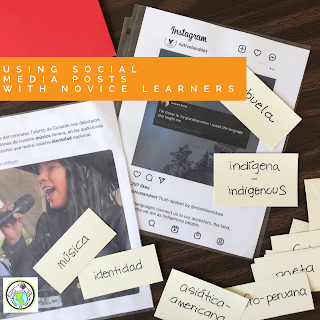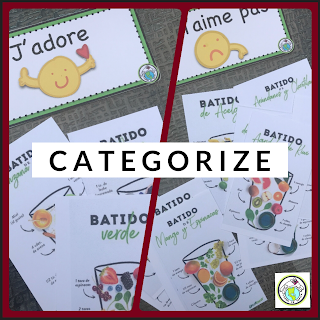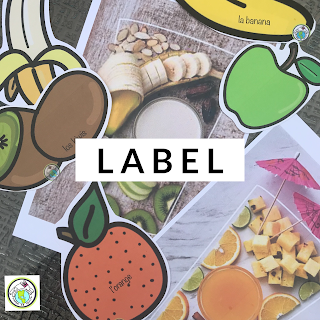*EXTRACT ONE PIECE OF INFORMATION*
This is a key component of my planning when using infographics and other posts. Sometimes, as teachers, we see all the great info on an infographic and try to integrate much of it into a lesson or activity-consider instead just focusing on ONE piece of info that can be gleaned from the visual. So, for example, I use a series of infographics, tweets, and Instagram posts to have my 4th graders fill in a map of where jaguars live. Each visual is about one country, which kids have to identify in order to color in their map, eventually having a series of countries colored in.
Before handing out the visuals, remind students to look for text markers such as bold text, titles, hashtags, and/or labels on photos/images. This helps them key into where they can find the info they are looking for, as opposed to becoming lost in the sea of text. (I learned this reading strategy from my sister, who's also a teacher!). This is a skill kids are learning in their general ed classes in upper elementary, so well suited for this age group (as opposed to lower elementary students). For this mapping activity, every kid receives one image to start with, and then they pass the image to a classmate, repeating until all images have been seen by each individual student. Ultimately, with this particular activity (maps & jaguars), my goals are twofold: revisit and reinforce country names & map locations, and develop by exploring & discovering (rather than me telling) the distribution of jaguars in the Americas. There is the added benefit of seeing kids looking at other parts of the image/infographic once they've colored in the appropriate country!
Another, similar activity extracting one piece of information is to notate data points, such as numbers or percentages, creating a table or graph in the process.
In the activity shown above, I found infographics for the most biodiverse countries in our hemisphere, posted them as an activity in Seesaw so they could see them, and had students fill out the table, counting numbers of bird, mammal, reptile, plant, and fish species in these countries. My goal is to have kids gain an appreciation of the biodiversity within these countries (including Ecuador, Colombia, México, Perú and Venezuela, along with the Amazon Rainforest more generally). For comparison, I also included a visual with the biodiversity of our state of Maine. Again, revisiting and reinforcing country names is part of spiraling this all through my gradespan, as well as the category words 'mamífero, planta, etc'. You could teach/practice big numbers with this as well!
And, with both of these activities, they are embedded in lessons about biodiversity, the environment, & connections with the peoples who inhabit the same territories.
Here's another example, from my Mis Mascotas Theme Pack , that utilizes graphics related to what pets can eat-kids use these to mark 'yes' or 'no' on their activity page. This doesn't require them to know the vocabulary for all the food words, although this does provide spiraling opportunities in a new context! Again, I post these on Seesaw so kids can see them all at the same time (before the advent of 1:1 devices, I printed these out and used them in a centers activity). The goal of this activity is for kids to learn more about responsible pet care as part of our Pets theme :)
Don't be afraid to cut apart those authentic resources, either! In this example, I printed out one copy of the infographic on stiff paper and cut out the chile peppers, and one copy as a 'self check' after they've followed the instructions (which I video tape and have on an Ipad). The task is to put the cut out chiles in order based on spiciness, simple but fun (and for upper elementary a good review of math facts in the form of ordering bigger numbers). You can circulate to the group/partners to ask them questions in the target language, such as do you like spicy food? what was a surprise? etc Find this infographic here and don't miss our Olivia hace salsa Theme Pack!
Social Media posts are another fantastic resource to bring authentic voices and images to your classes. Both the text and the photos/pictures can be a source for language learning & practice-in the example below, I've written out bunches of cards with target vocabulary on them; Instagram & Twitter posts are laid out on tables around the room and cards are distributed to students. Like a scavenger hunt, kids have to find a post or picture that matches the vocabulary card they have and place the card on it/next to it. Linking to the images, in particular, fosters consideration of the meaning of the word on the card. You can also have some of the posts be in English, but the cards are still in the target language which again encourages kids to think about the meaning of the word (you can see an example in the photo related to a Nativelandnet Instagram post in English which mentions 'grandma'-the card says 'abuela').
I really like having some of the cards be words kids really need to search for in the text, as well as words which represent bigger ideas & concepts we are working on in our ABAR (anti bias, anti racist) work.
Don't miss our ImillaSkate Mini Theme Pack with cards and links to a video for this exact type of activity!
For young (and older!) students who may not be reading yet, CATEGORIZING is an accessible activity that can be done in lots of different ways-using our Preferences Bulletin Board Cards, for example (French version here & Spanish version here) or diagrams like Venn (grab our Graphic Organizers for all Languages here). In the photo below, you can see I've printed out a bunch of 'Batidos' (Shakes) with various ingredients-kids can then sort them into whether they like each one or not. This is a great centers activity or with a partner. These images (and many others) can be found on my Pinterest board by clicking here.
On the same Pinterest board I also have some smoothies that do not have a label-which provides an excellent opportunity for kids to add them! Younger kids can use our printable play food, or you can provide written cards without pictures for older kids. (Play food in Spanish, French, Russian, German, English)
Focusing in on "simpler" ways to use infographics and other visuals can make these much for accessible for our novice learners, while at the same time giving them opportunities to interact with these resources in authentic contexts.
Did you know? I regularly include links to infographics and other visuals in my Mira el Mundo and Mira el Mundo Jr Magazine issues! All back issues, along with current ones, still available in our shop :)







